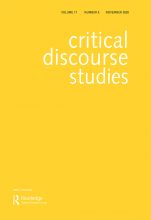The paper maintains the complementary nature of technological practice and discursive content in the process of meaning-making in digital jihadist discourse. The study shows that digital practices of strategic sharing, distribution and campaigns to re-upload textual materials are made possible by exploiting SMC communicative affordances. As for the analysis of discursive content, the paper focuses on YouTube and highlights strategic patterns and covert references in an IS-produced flagship video. It illustrates how IS discourse constructs its envisaged in-group/outgroup by (re-)symbolising current events within historical, political and ideological conflict scenarios, i.e. the incessant resistance and legitimacy of forces of virtue vs evil. By foregrounding symbolic references to military outgroup actors, IS legitimises its own violence and projects a powerful self-identity against a (perceived) global hegemony. The paper shows how the combination of a technologically savvy operation and a resistant, anti-hegemonic narrative, embedded in a strategically framed symbolism of Islam, may resonate with global (quasi)-diasporic digital consumers.
